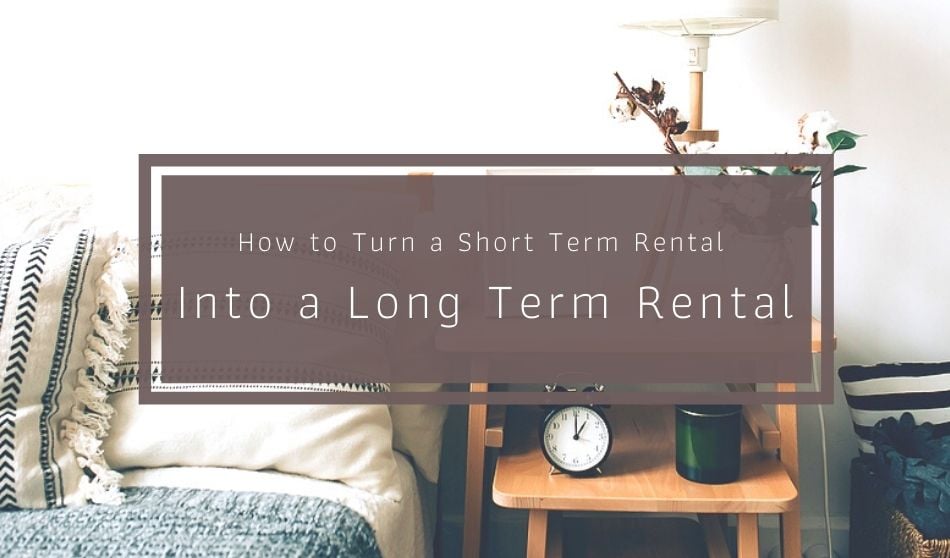
You’d be hard-pressed to find an industry that’s been hit harder than the short term rental industry. When the pandemic lockdowns hit in late March, Airbnb alone lost $1.5 billion in bookings virtually overnight, forcing the company to secure $2 billion in emergency financing. Short term rental hosts around the country are suddenly struggling to meet their financial obligations.
The pandemic has been particularly brutal for popular vacation hotspots – places like the Florida Gulf Coast, Gatlinburg in the Great Smoky Mountains, and small West Coast cities aren’t receiving the same attention from vacation-goers.
But there’s a well-established roadmap for short term rental owners who want to transition into long term rental landlords.
Even before the pandemic hit, many experts were advising owners to transition their investments into longer-term rentals, warning that the short term rental boom was unsustainable and potentially volatile. And while long term rentals are an entirely different beast than short term rentals, the transition can be done if owners follow a few fundamental principles.
Let’s go over the basic blueprint to convert a short term rental into a long term one.
Updating the Home
The needs of a long term tenant are going to be totally different from the needs of a short term tenant. Someone staying for a weekend probably isn’t going to care about the appliances, but they will care about the aesthetics and design of the unit. The opposite is true for long term tenants.
Long term tenants will be looking at very basic, straightforward features of your property, such as appliances, renovations, lighting, and neighborhood. If you’ve neglected these features up to now, you should consider upgrading.
Long term tenants will also be looking at your property as a potential home, as opposed to a temporary vacation pad. That means that, just as if you were looking for a buyer, you should present a blank, impersonal template.
Remove all clutter, furnishings, artwork, and much of the furniture before you show the property as a long term rental. Tenants need to be able to project their own tastes and preferences onto the property, and an excess of style only gets in the way.
Learning to Screen Tenants
When you use Airbnb, you can rely on the user’s rating to gauge whether they’re a reliable guest. But when it comes to long term tenants, there’s no catch-all rating that tells you what kind of tenant they are. And the stakes are higher, too—a long term tenant can be very difficult to evict in places with strong tenant protections, even if they stop paying rent or break other terms of the lease.
You’ll want to do a thorough screening of any potential long term tenants, including a background and credit check. Try to also obtain references from past landlords.
Getting the wrong tenant into one of your properties can lead to a huge financial drain as well as months of stress.
Getting the Word Out
Airbnb’s website and app, presents a fantastic, centralized way to market short term rentals to thousands of users. But getting the word out about a long term rental is a much more complicated and, in some ways, old-fashioned matter.
You’ll want to use every available avenue to market your rental. That means everything from social media accounts to posting fliers on community boards and at busy intersections. Use free sites such as Craigslist, and don’t be afraid to post multiple times a day. And a slick “For Rent” sign out front could easily snag a qualified tenant—experts suggest using high-quality signage and possibly posting multiple signs around the property.
In terms of emerging technology, Zillow and Trulia are two platforms worth using to get more eyeballs on your rental, though other free options can be beneficial.
Brushing Up On Local Laws
In most cities, short term rentals and long term rentals are governed by completely separate laws, and one of the biggest reasons that Airbnb was so successful early on is that their rentals were more or less unregulated. That isn’t the case for long term rentals.
Once you convert your property to a long term rental, you’ll have completely different obligations and rights as a landlord—and so will your tenant. Your property may even fall under rent control laws, which would heavily restrict how much you can charge for your unit and whether you’ll be able to remove a problematic tenant.
You’ll also be subject to different tax obligations, which could have a huge impact on your net income. Make sure you research local landlord-tenant laws or consult with an experienced local lawyer before you sign any paperwork.
Learning How to Write a Lease
Airbnb did a lot of the legwork for property owners by crafting comprehensive “terms of agreement” that outlined extensive protections for the company and for property owners. When you’re a landlord, though, the burden of that work falls on you.
A good way to approach writing a lease is to keep in mind that if it’s not in the lease, it’s not enforceable—so make sure you include everything. Start with basics such as naming the parties of the lease (you and the tenant), the rent, when the rent is due, what the late fees (if any) are, and the length of the lease.
Next, you’ll want to address some secondary concerns. What if either party wants to terminate the lease early? If you want to limit occupancy—i.e., limit who else is allowed to stay in the property—make sure you spell that out in the lease. Many landlords allow guests for a limited amount of time, but that’s up to you. Be sure that you understand the Fair Housing Act and your obligations as a housing provider before creating your lease; there are limitations you can set for a vacation home that you cannot legally set for a long term rental property.
If you’re unsure about your lease or have legal questions, you should consider consulting with a landlord-tenant lawyer to go over your lease with you. If this still sounds like a lot to manage, or you live in another town from your rental, you may benefit from hiring a property manager to oversee the day-to-day business of your rental property.
Determining a Viable Rent
If you simply multiply your nightly Airbnb rental rate by 30 and set that as your monthly rent, you’re probably going to have a pretty hard time finding a tenant. As you probably already know if you’re an Airbnb landlord, short term rates are much higher than monthly rates — partly to defray the costs of things like cleaning, fees, and more intense property management, and partly because of the higher vacancy rate for Airbnb. (Some analysts estimate the average Airbnb rental was occupied about half the time.)
A general rule that many experts recommend is to set your rent price at 0.8% to 1.1% of the home’s value. If your home is worth $300,000, a rent between $2,400 and $3,300 would be viable. Exactly where your rent should fall in that spectrum will depend on the health of your local market, nearby amenities, and the rent of similar properties. Naturally, you should always use the local market as a guideline. Finding comparable properties and their respective rental rates can help you set the rent at a reasonable price while avoiding vacancies.
Successfully Transition to a Long Term Rental
Transitioning from a short term rental to a long term rental can be more complicated than it seems. The rent calculations are different, the laws governing each type of rental are completely separate and, without Airbnb to act as a buffer, the legal and financial stakes for both landlord and tenant are much higher.
But it can be done, and there are huge rewards for owners who make the transition. Long term rentals may not be as profitable in the near term, but they can be much more stable and less stressful than managing a high-turnover short term rental. Make sure you understand what you’re getting into, and by next year, you might be wondering why you ever bothered with Airbnb.
If you’ve ever turned a short term rental into long-term, share tips in the comments below!





